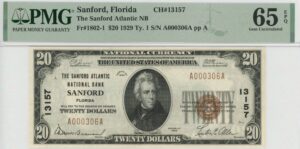SANFORD
The Mayaca or Jororo Indians inhabited the shores of Lake Monroe at the time of European contact. By 1760, however, war and disease had decimated the tribe, which would be replaced by the Seminole Indians. Florida was acquired by the United States from Spain in 1821, but the Seminole Wars would delay settlement. In 1835, the Seminoles burned the port of Palatka on the St. Johns River, then the major artery into Central Florida from the East Coast. Consequently, an army garrison was established upstream, on the southern side of Lake Monroe near a trading post. Called Camp Monroe, the log breastwork was attacked on February 8, 1837. It would be strengthened and renamed Fort Mellon in honor of Captain Charles Mellon, the sole American casualty.
General Zachary Taylor had a road built connecting a string of defenses from Lake Monroe to Fort Brooke (now Tampa). The town of Mellonville was founded around Fort Mellon in 1842 by Daniel Stewart. In 1845, Florida became a U.S. state, and Mellonville became county seat of Orange County, formerly called Mosquito County with its county seat across the lake at Enterprise. Orange groves were planted, with the first fruit packing plant built in 1869. In 1870, “General” Henry Shelton Sanford bought 12,548 acres (50.78 km2) to the west of Mellonville and laid out the community of Sanford. Believing it would become a transportation hub, he called it “The Gateway City to South Florida.”
Several groups of Swedes were imported as indentured servants to do the back-breaking labor of establishing a new town and clearing the sub-tropical wilderness in advance of creating a citrus empire, arriving by steamboat in 1871. Incorporated in 1877 with a population of 100, Sanford absorbed Mellonville in 1883. The South Florida Railroad ran a line from Sanford to Tampa, later the Jacksonville, Tampa and Key West Railroad ran a line to Jacksonville, and the area became the largest shipper of oranges in the world. Arriving by steamer in April 1883, President Chester A. Arthur vacationed a week at the Sanford House, a lakeside hotel built in 1875 and expanded in 1882.
In 1887, the city suffered a devastating fire, followed the next year by a statewide epidemic of yellow fever. When the Great Freeze of 1894 and 1895 ruined the citrus industry, farmers diversified by growing vegetables as well. Celery was first planted in 1896, and until 1974 the community would be nicknamed Celery City.
On December 1, 1891, merchant William Clark and registered African American voters of Goldsboro incorporated as a town just to the south of Sanford.
Source: Wikipedia
Recent Articles
- Browse Videos of Florida’s Historical Towns and Banks
- Florida Currency Museum Open Showcasing The William Youngerman Collection
- State of Florida Civil War Currency
- Recent Acquisitions
- Mr. and Mrs. Youngerman attend the inagural “The Value of Money” exhibit
Notes & Currency
- 18__ Fernandina $3 Obsolete Note
- 1882 $50 Jacksonville Note Charter #3869
- 1902 $10 Punta Gorda Note Charter #10512
- 1882 $5 Palatka Note Charter #3223
- 1902 $5 Key West Note Charter #7942


















